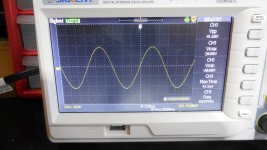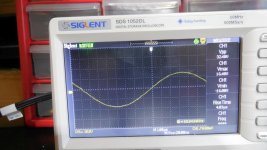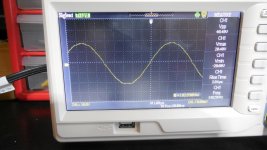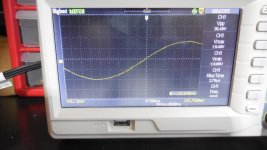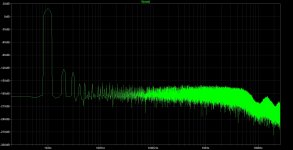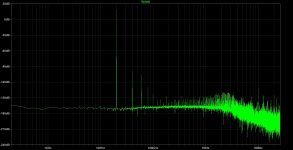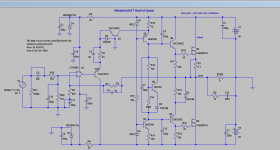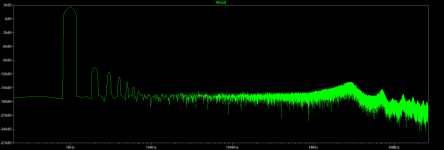In the sim it helps!
Will try it. Maxim was suggesting this diode several posts back, I guess
he was right.
I even have a space for it on the PCB (reserved for BJT Quasi version).
Will try it. Maxim was suggesting this diode several posts back, I guess
he was right.
I even have a space for it on the PCB (reserved for BJT Quasi version).
Of course it is better. Distortion is reduced and does not depend on the spread of transistor parameters.
there was a case with a diode
In the sim it helps!
Will try it. Maxim was suggesting this diode several posts back, I guess
he was right.
there was a case with a diode
Last edited:
This is 'as built' version.
With the diode, idle current needs to be re-adjusted.
In the evening, will try different opamps.
Would like to get higher slew rate.
With the diode, idle current needs to be re-adjusted.
In the evening, will try different opamps.
Would like to get higher slew rate.
Attachments
Last edited:
post 316. Make a model in the LTSWow. Qhex with diode gives the lowest distortion and the most beautiful THD profile among all versions. Incredible. Waiting for listening impressions.
Wow. Qhex with diode gives the lowest distortion and the most beautiful THD profile among all versions. Incredible. Waiting for listening impressions.
You run it with 4 amps of idle current.
After adding diode, change idle pot value (~3.5kOhm) to lower idle current.
You run it with 4 amps of idle current.
After adding diode, change idle pot value (~3.5kOhm) to lower idle current.
You are right i was wrong. Still better result.
I will do this option
Double drivers and feedforward correction? Stunning.
minek,
Yesterday I was already playing with the sim and sent you the asc file with D5 added to the schematic and also D8 changed to a RED LED to see how distortion profile has changed.
Today, I replaced Q2 for 2SA1381C, distortion profile is much better indeed.
Yesterday I was already playing with the sim and sent you the asc file with D5 added to the schematic and also D8 changed to a RED LED to see how distortion profile has changed.
Today, I replaced Q2 for 2SA1381C, distortion profile is much better indeed.
Attachments
R14=1k8, trimpot 1k3 would be better with LED.
R14=2K2 is OK for me.
R10/R11 is reduced to 51/100 ohms.Distortion will decrease dramatically. But the heating of transistors will increase. Diagram from post 326
> R10/R11 is reduced to 51/100 ohms.Distortion will decrease dramatically. But the heating of transistors will increase. Diagram from post 326
Yeah, who needs hotter transistors...
Distortion is already very low, I'm fine with these numbers.
150/75 Ohm was a compromise between low(er) heat being dissipated, and distortions.
It's just a sim, real Thd numbers will be totally different story 🙂
Later on, I'm going to measure this amp with audio analyzer, let's see if real numbers are as good as the sim.
I tried these op-amps (no music, just oscilloscope):
1) TL071 - very good, as usual
2) TLE2081 - same
3) TLE2071 - same
4) LT1357 - not good, oscillations
5) LF356 - very good, waves looking kind of better
6) LT1056 - very good (when I tried it in LMK amp, it was not stable)
So basically, all of them look the same on the oscilloscope with the exception of 4) being bed, and 5) being the best in my non-scientific gut feeling.
Slew rate is the same, more or less, on all of them.
Will repeat the same test with music, later on.
Yeah, who needs hotter transistors...
Distortion is already very low, I'm fine with these numbers.
150/75 Ohm was a compromise between low(er) heat being dissipated, and distortions.
It's just a sim, real Thd numbers will be totally different story 🙂
Later on, I'm going to measure this amp with audio analyzer, let's see if real numbers are as good as the sim.
I tried these op-amps (no music, just oscilloscope):
1) TL071 - very good, as usual
2) TLE2081 - same
3) TLE2071 - same
4) LT1357 - not good, oscillations
5) LF356 - very good, waves looking kind of better
6) LT1056 - very good (when I tried it in LMK amp, it was not stable)
So basically, all of them look the same on the oscilloscope with the exception of 4) being bed, and 5) being the best in my non-scientific gut feeling.
Slew rate is the same, more or less, on all of them.
Will repeat the same test with music, later on.
Last edited:
If anybody is going to build it with IRFP fets, you have to sim it with IRFP models.
Some values might need to be different (E.g. gate stoppers will need to be higher - 47 Ohm at least for IRFP240).
IRFP260 should be fine with 22 Ohm stoppers.
Some values might need to be different (E.g. gate stoppers will need to be higher - 47 Ohm at least for IRFP240).
IRFP260 should be fine with 22 Ohm stoppers.
Later on, I'm going to measure this amp with audio analyzer, let's see if real numbers are as good as the sim.
I tried these op-amps (no music, just oscilloscope):
3) TLE2071 - same
4) LT1357 - not good, oscillations
5) LF356 - very good, waves looking kind of better
6) LT1056 - very good (when I tried it in LMK amp, it was not stable)
.
RC correction can be set between the inputs of the operational amplifier. 100-1000ohm and 5-20pF. From your division, for example LF356/ very good OU. I will add OPA132/opa134 amplifiers to your list
- Home
- Amplifiers
- Solid State
- Unusual amp from 1987
